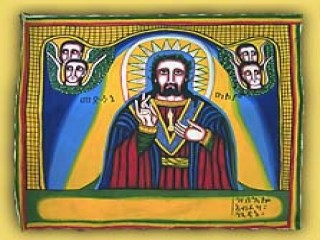
Ezana Of Axum biography
Date of birth : -
Date of death : -
Birthplace : Axumite Kingdom, Ethiopia
Nationality : Ethiopian
Category : Historian personalities
Last modified : 2022-02-15
Credited as : Ruler, king of Saba and Salhen, Himyar and Dhu-Raydan, 4th century
Ezana (active early to middle 4th century) was an Ethiopian king during the Axumite period. His reign marked a turning point in Ethiopian history because Christianity became the state religion when he became the first Christian king.
Very little indeed is known about Ethiopia before the 12th century, but the reign of Ezana in the early to middle 4th century stands out because of the relatively abundant inscriptions which he left. Axum was the predecessor kingdom of modern Ethiopia and was located in the northern part of the country. Ezana succeeded his father, Ella Amida, to the kingship while still a child, and Ezana's mother, Sofya, acted as his regent until he grew up. The young Ezana was tutored by one of his father's counselors, Frumentius, who was a Christian from Syria. Frumentius later converted Ezana to Christianity and became the head of the new Ethiopian Church.
The first known inscription left by Ezana was written on a stone stele in three languages, Geez (Old Ethiopic), Sabean, and Greek. By this time Ezana was ruling the kingdom himself, and he records the extent of his domains and some details of military expeditions to the north. He sent his brothers, Shaiazana and Hadefan, to subdue the Beja people, who had been raiding trading caravans in the north. Ezana showed his diplomatic skill by his wise treatment of these people after they were conquered. Instead of suppressing or enslaving them, he lavished wealth upon them and had them resettled in a fertile area within Axum where they were able to live in prosperity and peace. Several other, later inscriptions have been found that mention expeditions to places which can no longer be identified, and the general confusion of terminology makes it difficult to determine the precise extent of Axum at that time. It is not, for example, clear whether Ezana himself either ruled or invaded southern Arabia.
Through such men as Frumentius, Axum maintained close contacts with the Christian nations of the eastern Mediterranean. It was the rise of Islam several centuries later which isolated Christian Ethiopia from the rest of the world. There is no official and explicit record of Ezana's conversion to Christianity, but the fact of this event is shown by the changes in the symbols used in Axumite coins. Ezana's fifth and last known inscription pays tribute to the Christian god for the first time, and it goes on to describe his very important conquest of the ancient city of Meroe in northern Sudan. This conquest completed the downfall of the kingdom of Kush, which had once ruled Lower Egypt.
Traditions, which were written centuries later, say that Ezana adopted the Christian name of Abreha; however, this identification is controversial, and some modern historians believe that Abreha was another individual who ruled centuries later. Ezana is also remembered as having been a great builder, and he may have been responsible for the erection of the great obelisks still visible in the town of Axum.
An English translation of Ezana's last inscription is in Basil Davidson, ed., The African Past (1964). Very little is known about Ezana, and there is no biography of him. A useful account of early Ethiopia by G. W. B. Huntingford, "The Kingdom of Axum," is in Roland Oliver, ed., The Dawn of African History (1961; 2d ed. 1968). E. Sylvia Pankhurst, Ethiopia: A Cultural History (1955), contains more material on Ezana than most general histories. Edward Ullendorff, The Ethiopians (1960; 2d ed. 1965), is a good general source.
















